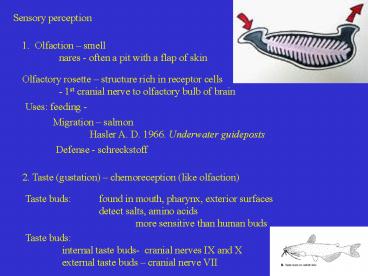Sensory perception - PowerPoint PPT Presentation
1 / 10
Title:
Sensory perception
Description:
Sensory perception. 1. Olfaction smell. nares - often a pit with a flap of skin. Olfactory rosette structure ... Leptocephali, elver, adults. Migrations: ... – PowerPoint PPT presentation
Number of Views:190
Avg rating:3.0/5.0
Title: Sensory perception
1
Sensory perception
Olfactory rosette structure rich in receptor
cells - 1st cranial nerve to olfactory bulb of
brain
Uses feeding -
Migration salmon Hasler A. D. 1966. Underwater
guideposts
Defense - schreckstoff
2. Taste (gustation) chemoreception (like
olfaction)
Taste buds internal taste buds- cranial nerves
IX and X external taste buds cranial nerve
VII
2
Lateral line system Neuromast system
Lateral line neuromasts in a canal under
scales - cranial nerve X around facial area
CN VII
Superficial neuromasts located on skin surface
Some pits are modified for electroreception Elasm
obranchs organs of Lorenzini Gymnotiformes and
Mormyriformes generate weak electric fields
detect objects in water maintain straight body
shape constant field
3
Acoustico-lateralis system orientation and
hearing (CN VIII)
Labyrinth set of three semi-circular
canals set in three planes, and three otoliths
Orientation semicircular canals and utriculus
and sacculus
Static equilibrium position of the body in
relation to earth Dynamic equalibrium sensitive
to changes in position of body
Hearing lagena contain otoliths used in sound
detection
Weberian apparatus transmits sound vibrations
to otoliths Yans research
Clupeids and Mormyrids extensions of swim
bladder near inner ear
4
Light reception
Pineal organ at top of brain detects light/
dark very important for reproduction
Fish eye typical vertebrate eye (CN II)
Very good close vision not good at distance
Focusing- better in predators
Rod and cones associated with depth
Light levels pigment (retina, cornea/
lens) move cells tapetum lucidum guanine
5
Reproduction
Dioecious separate males and females sexual
dimorphism intromittent organs, tubercles,
kype sexual dichromatism
Hermaphrotism individuals can produce egg or
sperm sequential hermaphrodites
Parthenogenesis sperm penetrates egg to
stimulate division but no DNA is contributed to
young
Internal vs external fertilization
Sperm vary in shape released through vent
milt sperm activated by water
6
Ova vary greatly in size .5mm- lt8 cm often
inversely related to number produced
Energy stores yolk and oil Vitellogenesis
liver produces vitellogenin estrogen
ovulation sturgeons and paddlefish
gymnovarian - most bony fishes - cystovarian
Ovipary (egg-laying) most common Ovovivipary
(live bearing) eggs maintained in body Vivipary
(live bearing) young receive nutrients from
mother
Egg types buoyant (pelagic)
float semi-buoyant (semipelagic) need flow
demersal heavy, often sticky
7
Basic Reproductive Strategies based on Spawning
Habitat (Table 9-1, Moyle and Cech, 2004)
Non-guarders Pelagic spawners (mass
spawners) Benthic spawners Brood hiders
Guarders protect eggs until they
hatch non-nest builders nest builders -
Bearers carry embryos while they
develop. Mouth brooders 2
8
In General Fecundity decr with parental care
Egg size inc with parental care - inc size leads
to increased incubation - inc size leads to well
formed young at hatch
Egg types buoyant, semi-buoyant no PC
demersal usually PC
PC associated with sex dimorphism, degree of
courtship, degree of territoriality and defense
Reproductive patterns Semelparity spawn once
and die Iteroparity spawn in repeated events
What age to spawn? size and number of eggs
affected by female size trade off
9
Migrations Catadromy most of life is spent
in freshwater and adults migrate to saltwater to
breed Leptocephali, elver, adults
10
Migrations Anadromy most of life is spent in
saltwater and adults migrate to freshwater to
breed Alevins, smolts, adults































